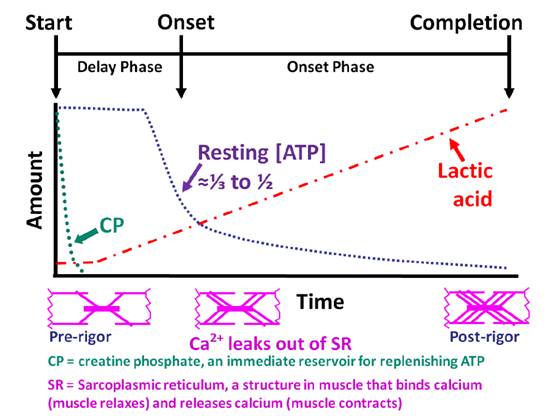Muscle Extensibility and Rigor Mortis
Muscle ATP, a high energy compound used by muscle to perform work, content directly relates to muscle extensibility (the ability to contract and relax). In pre-rigor muscle where ATP is high, the tissue is soft, extensible, and reacts like living muscle. When the ATP content declines to critically low levels after death, the tissue will become firm and inextensible.
It is extremely important to know that during the delay phase of rigor (Fig. II-6), muscle is uniquely susceptible to environmental conditions, some of which may be good, some bad. For example, carcasses can be electrically stimulated during slaughter to speed the onset of rigor - a desirable event in beef and lamb, where as electrical stimulation of pork carcasses usually lowers pork quality. If pre-rigor muscle is frozen or hot-boned before any rigor onset has occurred, the consequences can be very undesirable. The importance of timing of some processing conditions cannot be overstressed.

Figure II-6. Rigor Mortis as a Function of Meat Chemistry and Time The timing of the stages of rigor mortis varies between species. Poultry is often in rigor within 1-2 hours, pork within 4 to 6 hours, beef and lamb within 7 to 15 hours after exsanguination.
The time line from start to onset to completion of rigor mortis for carcasses with normal quality and pH decline is illustrated in Fig. II-6. Once the ATP reaches a critically low level at about 1/2 of the original value in a resting muscle at higher temperatures and ⅓ at less than 15° C (the ATP arrow), then the muscle starts to get stiff and pre-rigor processing can start with less likelihood of toughening due to shorter than normal sarcomeres. During the decline in ATP levels at the onset (arrow) of rigor mortis and when the ATP concentration is about ⅓ to 1/2 of the original ATP level, some calcium starts to leak out of the sarcoplasmic reticulum (SR). The elevated calcium stimulates muscle contraction and the sarcomeres shorten to the extent that the skeleton will allow. The pH is gradually declining due to the increase of lactic acid. In rested animals, the creatine phosphate (CP) helps immediately to regenerate muscle ATP when there is a need to maintain high levels. However, many animals have little or no CP in muscles at the time of slaughter because it has been used up during animal transport and lairage. Therefore, ATP must be generated from another source of energy production.
Glycogen is the major storage form of energy in muscle and is metabolized to help supply ATP, thus keeping meat in the pre-rigor state. Animals with lower than normal levels of muscle glycogen at the time of slaughter will have a shorter delay phase and go into rigor faster than normal (see DFD pH decline curve, Fig. II-4).
If carcasses have an accelerated pH decline (as with severe PSE) due to the rapid production and consumption of ATP, the accumulation of lactic acid is more rapid and rigor onset is much faster (less than 1 hr to 4 hr). Unfortunately, the meat temperature is often still high, which facilitates higher than normal denaturation of protein.
Sarcomere shortening can be counteracted by adding salt to the meat before rigor onset to the meat to partially inhibit rigor onset, thus improving WHC. Alternatively, pre-rigor excision could be delayed until the onset of rigor where shortening would not be greater than normal.
At the bottom of Fig. II-6 is three sarcomeres representing the contractile states of the muscle at the beginning, onset, and completion of rigor. The left, prerigor sarcomere can still contract and relax, has a limited number of cross bridges, and is very sensitive to some meat processing conditions. The center sarcomere is shorter indicating that the muscle is shortening just as far as the skeletal restraint will allow. Calcium is leaking out of the SR (the sarcoplasmic reticulum) and stimulates muscle contraction and formation of cross bridges between muscle filaments. The sarcomere on the right represents the final contractile state of post-rigor muscle where the number of cross bridges between the filaments is greatest, the distance between muscle protein filaments if the lowest, and the meat is the least tender. Rigor, therefore, decreases WHC because of less total open space for entrapment and holding of water.
The time muscle remains in the sensitive delay phase of rigor depends upon the chill room conditions (temperature, air movement, carcass spacing, etc), the fatness and total mass of the carcasses, muscle location within a carcass, and the type of muscle cells (fibers) within a muscle. In addition, the state of the animal before death has major impacts on meat quality. Exhausted or highly excited animals go into rigor faster than rested animals because their total energy supply (creatine phosphate and glycogen) is less and the critical level of ATP needed to delay rigor is soon reached. Meat from excited animals at slaughter is very likely to exhibit some degree of PSE, less WHC, and may have greater spoilage potential (due to its wet surfaces) than normal pH meat. Meat from exhausted animals at slaughter will have a higher pH and WHC than normal but often has some undesirable quality characteristics (e.g., its darker color and greater susceptibility to microbial spoilage (due to the higher pH) even though it is just as wholesome and nutritious compared with meat with a normal rigor mortis pattern. These undesirable muscle properties result from the interaction between timing of the events, muscle pH, and carcass temperature; all three of which ultimately affect WHC.
The key to modulating WHC to improve yields, quality, and overall meat functionality is to be able to evaluate and inter-relate factors mentioned above into plant operations.